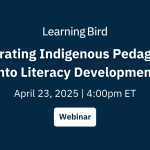Preparing for Orange Shirt Day
Educators can prepare for this important topic right from the beginning of the year!
While our learners may still be enjoying their summer vacation, many educators begin thinking about the beginning of the school year well before their holidays have ended. There are many things to consider as we welcome learners back to school. Something we should not overlook is September 30, or Orange Shirt Day and National Truth and Reconciliation Day. Are you wondering how you can discuss such a heavy topic with learners you are just getting to know at the beginning of the year? Keep reading for some ideas on how to successfully build classroom community to meaningfully observe Orange Shirt Day this fall.
Remember what Orange Shirt Day is all about
Most people have some basic knowledge about Orange Shirt Day. Orange Shirt Day grew out of the St Joseph Mission residential school Commemoration Project and Reunion in May 2013. Phyllis Webstad told the story of her new shiny orange shirt, a gift from her grandmother, being taken away at just six years old when attending residential school. This story inspired Orange Shirt Day and is still told to learners across Turtle Island each year. September 30 is a way for Canadians to discuss the effects of residential schools and their legacy, let survivors know they matter, and build bridges toward reconciliation.
If we think about these messages in our classrooms, there are some fundamental elements we can address at any time throughout the year. How can we show our learners they matter? Learn about them! Finding out what your learners enjoy and what makes them feel safe is a great way to start. Spend time getting to know your classroom community and the community at large. When you establish classroom expectations, co-create them with learners. These expectations should explain what values and behaviours represent respect and empathy. A positive classroom environment is crucial for learning and for entering into any discussion about the treatment of Indigenous Peoples in Canada and reconciliation.
Build community
Educators know how to create bonds with their learners; it is a cornerstone of good practice. While you may already have some strategies, you may also want to consider additional ways to bring Indigenous perspectives into your community-building efforts. Roger Simon (2005, p. 88, as cited in Wallace-Casey, 2022), a scholar who focuses on remembrance learning, asks, “What might it mean to live our lives as if the lives of others truly mattered?” As we build bonds with our new learners, we want to ensure we include activities that try to answer Roger Simon’s question. Taking the time to ensure our learners know what respect and empathy look like also means allowing them to practice these skills with one another and their community.
Getting to know your local Indigenous community or communities is a great way to encourage learners to begin creating connections. Try finding out whose land you and your learners are occupying by visiting Native Land Digital. Your local Friendship Centre can help you make connections with Indigenous community members if you do not have existing relationships. These actions can be part of the “getting to know you” activities you do with learners.
Find the right resources
This may seem like the most daunting part of commemorating Orange Shirt Day – but it does not have to be! Many educators and organizations have taken the time to carefully and thoughtfully construct resources that support learning about Orange Shirt Day. Here are some tips about what to look for:
- Resources that are age-appropriate for your learners. Different ages need different ways of accessing information about residential schools and survivors.
- Resources that encourage historical thinking, specifically those that help learners develop historical perspectives and do research. We want learners to know how to investigate the past for themselves and when to use these skills in the future. The concept of historical thinking comes from Seixas and Morton’s work on developing a framework that enables learners to think like historians and begin constructing their own narratives about the past. By encouraging historical thinking, we are making space for Indigenous narratives about history and its connection to the present.
- Most importantly, find resources that make room for Indigenous worldviews and dialogic learning.
Finding a single resource that does each of these things can be difficult! You may want to choose one and then emphasize elements that are missing by using another resource to supplement. To help you get started, here are a few recourse suggestions:
- Learning Bird – Orange Shirt Day Kit (Grades 7-9)
This free downloadable resource kit introduces learners to Orange Shirt Day and Phyllis Webstad’s story. Learners then engage in historical thinking and research to learn more about residential schools and survivors. The resource kit offers unique ways for learners to demonstrate their knowledge, such as word art, social media posts, and poems or songs to be shared with the community.
- Learning Bird and The Gord Downie and Chanie Wenjack Fund – Indigenous Languages and Secret Path Educator Resources (High School)
If your learners are familiar with the residential school system, then you may want to extend their learning using this kit. This free downloadable resource kit positions the story of Chanie Wenjack as told in Gord Downie’s Secret Path multimedia project as an opportunity to explore the topic of Indigenous languages and how they relate to Indigenous rights on a local/regional/national/global scale.
- Project of Heart (All grades)
Project of Heart is an inquiry-based, intergenerational and artistic journey that seeks the truth about the history of Indigenous peoples in Canada. Learners complete a series of activities, including decorating wood tiles and creating a display in the school, that teaches about residential schools and their long-lasting effects on Indigenous communities.
- Orangeshirtday.org (K-7)
This website contains a lot of information about Orange Shirt Day and is an excellent resource for educators. These resources include videos, books, and activities that are age appropriate and sensitive to both Indigenous Peoples and young learners. The activities encourage learners to use historical thinking skills and develop empathy.
How will you be commemorating Orange Shirt Day with your learners this fall? We’d love to hear from you, reach us here!
References
Wallace-Casey, C. (2022). Teaching and learning the legacy of residential schools for remembering and reconciliation in Canada. History Education Research Journal.






